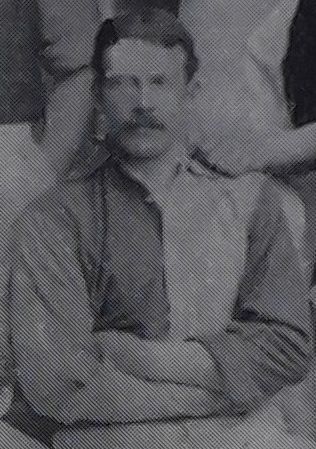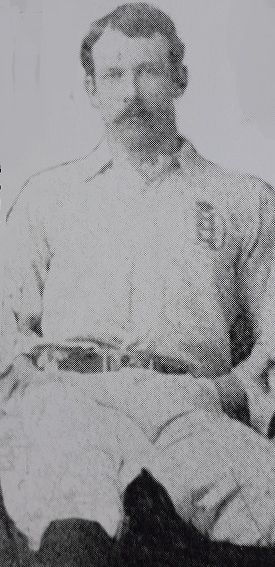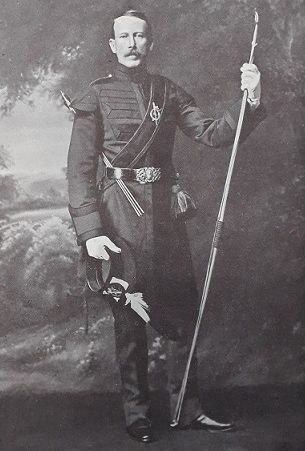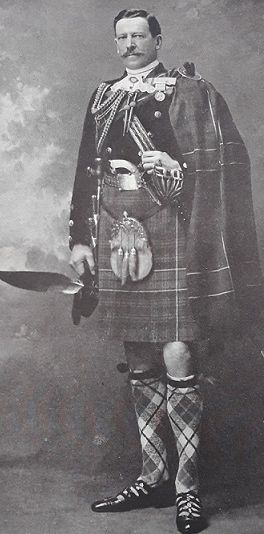The MacRaes of Eilean Donan
Feedback is important to a site like ours and in this case acknowledgement and thanks are gratefully extended to Michael Patterson, who read our previous pieces on Stuart MacRae, made contact and now has supplied us with far more information that we could possibly have accessed otherwise.

Stuart MacRae - Notts County
(Thanks to Michael Patterson)
So for those not yet in the know, here is a reiteration of who precisely was Stuart and what and who are the MacRaes of Eilean Donan. The simple answer to the question about the man himself is that he was a player for Notts County in the first half of the 1880s, a half-back, who went on also to play internationally. And the more convolut-ed explanation of the reference to Eilean Donan is that his family, as MacRaes of Conchra, was the one that some might say restored and others facilitated the creation of the castle, which since has become iconically Highland.
In fact both interpretations of the story can be said to be true. There was a ruined castle on an off-shore rock in Loch Duich, it lay on the edge of Macrae of Conchra clan territory and the heads of the clan would seem to have the right to do with it what he wished. And that, once he had bought it in 1911, John Gilstrap MacRae, younger brother of Stuart, certainly did or at least allowed architects, initially, again it is said, an Italian one and then George Mackie Watson, to do to great, if not necessarily historically-correct, effect.

Stuart MacRae in England Strip
(Thanks to Michael Patterson)
But back to the football. Stuart MacRae was a gifted all-round sportsman. He would later be a founder and the first president of Newark Golf Club, Newark being the town where he first entered the beer-malting trade. At the club a trophy in his name is still played for. Moreover, as a younger man, after rugby-only at school in Edinburgh, he seems to have taken to the beautiful game with equal ease. Indeed, having been born in 1855 and with Newark F.C. founded in 1868 and Notts County six years earlier still he was from his arrival in Nottinghamshire in the late 1870s not short of outlets to demonstrate his developing, round-ball abilities. And those skills were even enough for him in 1883 and by then an experienced twenty-seven-year-old to be called up to international duty.
Yet it would not be for Scotland, the birthplace of his parents and their and also his eventual place of burial, the reason being that Stuart had been born in India and until 1887 the sub-continent, indeed the Empire, was "considered" England. It was an interesting concept that continued until in 1887 a change was forced through and by the Irish. However, by then it would be too late, despite our man even being a Gaelic-speaker, a member of the elite Royal College of Archers, since 1822 the sovereign's official bodyguard in Scotland, and as eldest son the heir to clan-chieftainship his father held.

Stuart MacRae -
Member of the Royal Company of Archers and
Clan Chieftain of the MacRaes of Conchra
(Thanks again to Michael Patterson)
However, in purely footballing terms there was still more to come. England as a team was in tactical transition. It had, since being almost repeatedly beaten home and away by Scotland, for a decade tried to ape the Scottish 2-2-6 formation. And MacRae would play in 1883 against all three of the home-nations on the right side of a two-man half-back line. Furthermore, the next in 1884 it continued with the same set-up for the encounter with the Irish but for the one against Scotland there was a change. In it England fielded a three-man half-back line with MacRae now the middle man. It was not the first time 2-3-5 had been employed at international level. Wales had first used it in 1882. But it was a first for England and both the first and last for MacRae himself. Later that same season he broke his leg and would never play for the "Saxons" indeed the "Sasannaich" again.

John Gilstrap-MacRae
(Thanks to Michael Patterson)
Stuart MacRae would die in London in 1927, a wealthy man from the malting business he had married into. But that would be the end neither of his nor of Eilean Donan's stories. On his passing his body was carried to Kyle of Lochalsh by train and then overland by his clansmen to the clan-cemetery at Clachan at Duich's loch-head. And thus he would never see completion of the castle. That did not happen until 1932. But at least it was five years before the death in the castle itself of younger brother, John Gilstrap-MacRae, the actual instigator and overseer of the project. He too had been Indian-born, had married the daughter of an English textile magnet but clearly considered himself to be a Scot, indeed a Highlander, as demonstrated graphically by his photo and his burial too at Clachan.
Back to the SFHG Home page